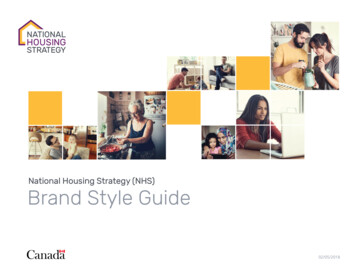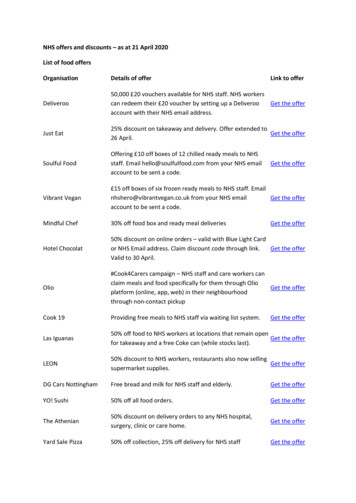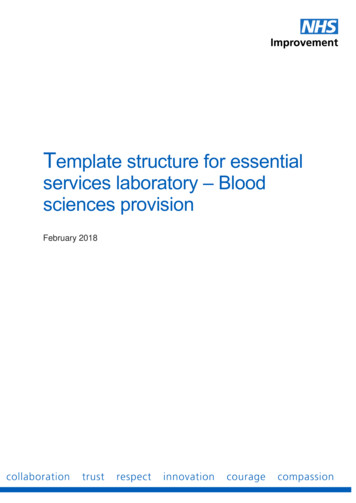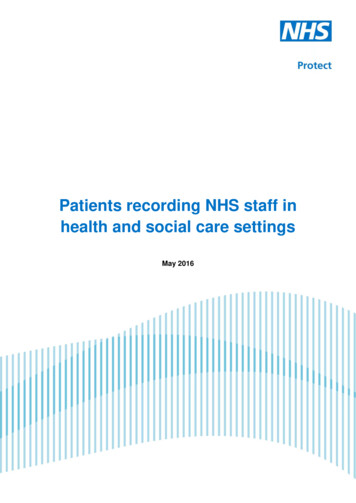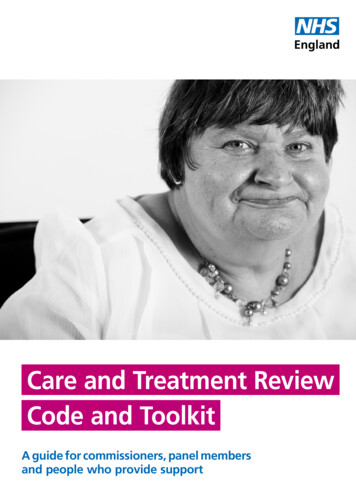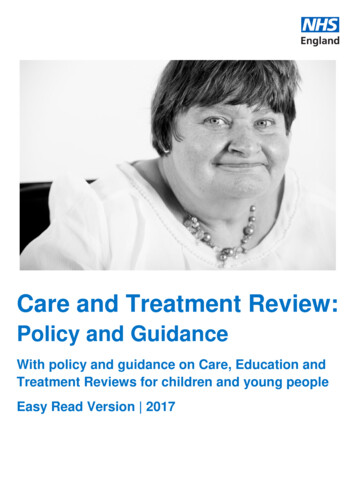
Transcription
Care and Treatment Review:Policy and GuidanceWith policy and guidance on Care, Education andTreatment Reviews for children and young peopleEasy Read Version 2017
Easy Read CTR Policy1 ContentsForeword from Gavin Harding . 4The Policy . 6Principles . 7Children and young people . 8CTRs and support in the community . 9Key lines of enquiry . 10Policy aims. 11CTRs and the Care Programme Approach (CPA) . 15PERSONAL principles and the standards . 16Consent and using information. 20CTR process – before, during and after . 21Key Lines of Enquiry . 25Going into hospital . 26Monitoring and intervention . 26Community CTR . .28Post-admission CTR . 29CTRs in hospital . 29Follow up after a CTR. 30Right to ask for a CTR . 302
Easy Read CTR PolicyLeaving hospital . 31First tier tribunals . 31Access to specialised services . 32Disagreements and escalation of concerns . 33Complaints about CTRs . 34Part A – CETRs for children and young people . 35APPENDIX 1 - Discharge steps and standards . 503
Easy Read CTR PolicyForeword from Gavin HardingI wish there had been Care and Treatment Reviews(CTRs) when I was in an assessment and treatmentunit.People have a right to a CTR if they are in hospitalfor a mental health problem or behaviour thatchallenges services. Or if they are at risk of goinginto one. They and their families can ask for one ifthey need one.CTRs can help people get support in the communityinstead of in hospital.The policy makes sure local services know about thepeople who are likely to need extra support - so theydon’t go into hospital unless there is no otherchoice.CTRs are about being person-centred. They thinkabout the person first and how it feels to be in theirsituation.4
Easy Read CTR PolicyWe had lots of feedback from people with learningdisabilities, autism, their families, providers, expertsby experience and professionals.Their feedback helped to change CTRs so they canwork even better.We have made our information for people andfamilies better, so their voices are heard.Gavin Harding MBE5
Easy Read CTR PolicyThe PolicyThis policy tells you about Care and TreatmentReviews (CTRs) and how the policy changed in2017.CTRs are part of NHS England’s plan to makepeople’s lives better.When we say people, we mean children, youngpeople and adults, who have learning disabilities,autism or both.CTRs are for people who have been, or may beabout to be admitted to a specialist mental health orlearning disability hospital. When the policy talksabout hospitals, it means this type of hospital.CTRs aim to reduce admissions and unnecessarystays in hospitals.The CTR is person-centred to make sure the careand treatment needs of the person are met. Andthat the person and their family are involved in thiscare and listened to.6
Easy Read CTR PolicyPrinciplesCTRs follow PERSONAL principles:Person centred and family centredEvidence basedRights ledSeeing the whole personOpen, independent and challengingNothing about us without usAction focusedLiving life in the communityThe CTR Policy is part of NHS England’s plan, calledBuilding the Right Support. This says what NHSEngland is doing in the Transforming Careprogramme, to change the way services areprovided.Thousands of CTRs have been carried out and a lothas been learned about how they can be madebetter. This is why the CTR Policy is changing.Between August and October 2016 hundreds ofpeople who have been involved in CTRs said whatthey thought would make the policy better.7
Easy Read CTR PolicyThe new policy is changing because of what peoplesaid. It focuses on the quality of CTRs and changesthat will help them work as well as possible.Children and young peopleReviews for children and young people will now becalled Care, Education and Treatment Reviews(CETRs).There is a new part in the policy about CETRs forchildren and young people.8
Easy Read CTR PolicyCTRs and support in the communityCTRs are part of NHS England’s plan calledBuilding the Right Support.This shows the need for local registers for peoplewho are at risk of admission to hospital. Theseregisters allow services to share information and planfor extra support in the community. This helps to cutdown the risk of going into hospital.Local registers also show which people may need acommunity CTR as this also plays a big part inmaking sure people only go into hospital when thereis no other choice. A community CTR will alwayscheck what extra support can be given in thecommunity first.People have to give their consent to say they agreeto be included on these registers.9
Easy Read CTR PolicyKey lines of enquiryThe 4 big questions in a CTR are:1. Is the person safe?2. Is the person getting good care now?3. What are their plans for the future?4. Does the person need to be in hospital fortheir care and treatment?Key lines of enquiryAn important change in CTRs has been key lines ofenquiry (KLOEs). They give the CTR panel a newway of making sure these four questions areanswered.Each KLOE has one key question followed by otherquestions that find out more. The CTR panel looksfor evidence to help decide what the answers are.KLOEs help the panel produce recommendations oractions that go into the CTR report.10
Easy Read CTR PolicyPolicy aimsCTRs aim to: Empower people and their families to belistened to about their own care and treatment Check that people are safe and have goodquality care. Also that their care and dischargeplans are good quality and progressing well Make sure people only go into hospital whentheir care or treatment cannot be safelyprovided in the community and it is the rightplace to be Review the care, treatment and dischargeplans of people who go into hospital in anemergency or crisis Check why people are admitted to hospitaland that people have good care plans andgood discharge plans for leaving hospital.It helps to solve any problems Work with the person, their family and othersto support people well in the community Make sure local services are involved - socialcare, Special Educational Needs SEN team,school or college. So that all issues can beaddressed and solutions found11
Easy Read CTR Policy Support a person-centred challenge to careand treatment plans Look at barriers to progress and say howthese could be overcome Result in a plan that has clear actions.And a named person who will do each actionwithin a certain time. The chairperson, who isthe person’s commissioner, makes sure thishappens.Why use these policies, standards and tools?To enable people and their families to understandand be involved.To make sure every CTR is carried out well.To make sure everyone knows what should happenand when.To measure how well these things are happening.12
Easy Read CTR PolicyAims of a CTRCTRs are used when a person is at risk of beingadmitted to a specialist learning disability or mentalhealth hospital.The CTR looks for alternatives to admission sothat going into hospital is the last answer.This is supported by local registers socommissioners can make sure the right support isprovided in the community. This reduces the risk ofgoing into hospital.If the person has to go into hospital, it follows theperson through their time there until they leave.It does this to check people are safe, have goodquality care, and can leave hospital as soon aspossible.Scope of the policyThe policy is for people who may be admitted to, orare patients in, any specialist learning disability ormental health hospital. It is for people with learningdisabilities, autism or both.It is not about going into a general hospital for aphysical illness or for people on an acute mentalhealth pathway when this is part of their preplanned crisis care.13
Easy Read CTR PolicyThere is a new part of the policy and guidance forCare, Education and Treatment Reviews(CETRs) for children and young people.The policy is based on the idea that people shouldbe supported to live in the community wheneverpossible.Policy contextCTRs began in October 2015 when the policy cameout. The policy has now changed.The new Policy was published in March 2017.CTRs bring extra challenge and checks to people’scare. They are carried out by a CTR panel.There are three people on each panel:1. An expert by experience. This is a person withlearning disabilities, autism or both, or a familycarer with experience of services.2. A clinical expert. This is someone qualified towork in health care. It might be a nurse,psychologist or psychiatrist, for example.3. The person’s commissioner. The commissionerpays for the person’s care. The commissionermakes sure that all the right things happen before,during and after a CTR.14
Easy Read CTR PolicyCTRs and the Care Programme Approach (CPA)CPA is a way of making sure that people who usemental health services get the care and supportthey need. CTRs cover many of the same areas asCPA but are different in these ways: They are independent of people’s care.This means they are not carried out by peoplewho provide the person’s day to day care They provide independent challenge andcheck that people are safe and receiving goodquality care They check plans and give extra support tosort out any problems that can hold up theprogress of the person’s care. And dischargeif they are in hospital They produce recommendations or actionswhich should be used in CPAs and in CPAplans CPA helps to make sure CTR actions arecarried out.15
Easy Read CTR PolicyCTR PERSONAL principles and the standardsFor children and young people’s CETRs and adult CTRs.1. Person-centred and family-centredThe person and their family will be giveninformation about the CTR.The commissioner will make sure the person hasgiven consent to having a CTR or that a bestinterests decision has been made before theCTR. Also that people named by the person areinvited.The person will get support to get ready for theirCTR, using the “My Care and Treatment Review”and “My CTR Planner”.Reasonable adjustments should be made to makesure the person is as involved as they want to be.The panel will meet the person and their familycarer if taking part.The person and their family get support tounderstand what will happen after a CTR.16
Easy Read CTR Policy2. Evidence basedEvidenceCTRs use key lines of enquiry (KLOE).The CTR will look for evidence to support itsfindings and write these in the KLOEs.The CTR checks that the best ways of workinghave been followed. This will be written in theKLOEs.Information to answer KLOEs will be gathered byproviders and commissioners before the CTR.3. RightsWhere the person’s human rights are not beingupheld, this will be written in the KLOEs. Action willbe taken.The CTR will ask about independent advocacyand legal representation for the person.4. Seeing the whole personThe CTR will ask about the person’s overall healthand wellbeing, not just their mental health orbehaviour. The person chooses if they want toinvite people important to them such as familycarers or advocate. Staff who support the personalso take part.The CTR should take about a day to complete.17
Easy Read CTR Policy5. Independent and challengingThe CTR panel has three people: the person’scommissioner (the chairperson), an expert byexperience and a clinical expert.The chairperson will make sure everybody knowswhat the CTR is about.The review team will have CTR Training.The panel will provide information aboutthemselves and introduce themselves to theperson.Where a CTR panel does not agree, people’sdifferent views will be written in the KLOE.The CTR will write down the reasons for, and theexpected outcomes, of an admission.The CTR will ask questions when care andtreatment is not in line with good ways of working.The CTR will ask whether the person’s care andtreatment could happen in a non-hospital setting.A follow-up CTR will check if any actions frombefore have not been done. It will ask why.6. Nothing about us without usEvery person will be supported to take part in theirCTR where possible.18
Easy Read CTR PolicyAfter the CTR, the chairperson will write a report.It will be sent out within two weeks of the CTR.7. Action basedIf a CTR panel thinks that someone is not safe,the chairperson will discuss it, write it in the KLOEand raise a concern.The CTR will look for any gaps in the person’scare and treatment. The panel will make suretreatment and discharge plans are in place.The outcomes of the CTR will be in the CPAcare plan.The CTR will name the people who will make surerecommendations go into other plans – such asEducation Health and Care Plan, Riskassessments, etc.CTRs will check that planning for discharge beginsas early as possible.The commissioner will make sure actions from theCTR are carried out on time.If this does not happen, the commissioner willexplain why.19
Easy Read CTR Policy8. Living life in the communityIf there are any reasons why the person’s careand treatment cannot be carried out in thecommunity, this will be written in the KLOE.The CTR will look for risk assessments and plansto keep the person and others safe.The CTR will look at whether the person hassupport to be part of their community.Consent and using informationCTRs and any use of personal information, will needthe consent of the person, parent or someoneallowed to give that consent.If there are concerns about the person’s capacity toconsent, this needs to be assessed in line with thelaw about capacity. This can lead to a decision in theperson’s best interest.The commissioner will check that the person hasbeen asked for consent.The CTR will say what information will be shared,with whom, how and why.20
Easy Read CTR PolicyWhere a person has capacity to consent, this means: The person understands why information isneeded, what information will be shared, withwhom, how and why. They choose to give or not give their consent. They understand they can change their mind, atany time, whether to give consent. They understand what happens if their consent iswithdrawn. If a person does not consent, not having a CTRdoes not affect the person’s day to day care.The booklet ‘My CTR Planner’ helps the personunderstand the CTR and consent.CTR process – before, during and afterCTRs should be positive, good quality and bringabout the best outcomes for the person.Before a CTRThe commissioner will check that the person hasbeen asked for consent and given the chance toinvite family and others to the CTR.21
Easy Read CTR PolicyIf taking part, the person’s family will be given all theinformation needed about and for the CTR.If the family cannot come, video or phonecommunication can be used.The commissioner will find a place where the CTRcan take place.Everyone involved will be sent information about theCTR. This does not include personal informationabout the person being reviewed.The commissioner will make sure the skills andexperience of the expert advisers are right for theperson having the CTR.Panel members will complete CTR training.The review panel will be sent review tools before theCTR.The person and family will be sent names and roles ofthe panel.An administrator will be needed to do the planningand communication for the CTR.22
Easy Read CTR PolicyAt the CTRThe CTR panel will include a commissioner,one expert by experience and one clinical expert.CTR panelActionsThe commissioner will chair the review and writedown findings and recommendations as actions.The review team will make sure they have agood understanding of the person and what theythink.The panel will say what the reasons are for theCTR, the CTR principles and the plan for theday.The person, family and advocate should be atthe CTR if taking part, or supported to take partin another way.The responsible clinician, named nurse and CPAcare co-ordinator must be at the CTR.Care staff who support the person should be atthe CTR.23
Easy Read CTR PolicyThe CTR takes about a day. Some CTRs maytake place over several days.The CTR should be in a place where the personfeels comfortable. The person should besupported by someone they choose and able totake part in the way they choose.CTR panel members will meet the family if theyare taking part.If families cannot be at the CTR, meetings canbe done by video link, phone, email or on adifferent day.Care plans, person centred plans, positivebehaviour support plans, etc will be reviewed.The care team should be interviewed, such as:community psychiatrist, community nurse, socialworker.The panel will ask if there are better alternativesto hospital. If the person is in hospital the panelwill always ask whether the person could bedischarged from hospital. And try to overcomeany barriers.Everyone will meet again at the end of the CTRto talk about findings, recommendations, andwho is doing what by when.24
Easy Read CTR PolicyThe commissioner will send a report to everyoneinvolved within 2 weeks of the CTR.The report will say who will do each action andby when. Everyone should understand what willbe happening, and how this will be followed up.The commissioner will raise any quality orsafeguarding concerns and make sure they arefollowed up in the right way.The team will challenge poor ways of workingand support a move towards community-basedcare.Key Lines of Enquiry responsibilitiesThe CTR will use KLOEs to guide the review.Each KLOE has a key question followed byother questions to gather information.Each KLOE will look for evidence.Each KLOE will record what the person andfamily say.25
Easy Read CTR PolicyGoing into hospitalA CTR does not decide whether to admit or todischarge someone from hospital.If a clinician decides that a hospital admission isneeded for a person who is a risk to themselvesor others, a CTR cannot stop this.A CTR can make recommendations about otheroptions in non-urgent cases.Monitoring and interventionLocal services should know about people whomay be at risk of admission to hospital.This is so people are supported to remain in thecommunity whenever possible.An important part of this is setting up localregisters of people who are at risk of admissionto hospital without the right support.A register has to: work across health, education and socialcare to bring about a better understandingof people who need this support. help commissioners decide what servicesa person may need to stay out of hospital.26
Easy Read CTR PolicyThings that can place someone at risk of admission may include: Significant life events such asbereavement or abuse Unstable / untreated mental illness Previous experience of admissions Being affected by the Mental Health Actor Deprivation of Liberty Safeguards Behaviour which is seen as challenging Having staffing or support problems Being unknown to services Having no fixed address Being in contact with law services. Being in crisis at Accident & Emergency Having no family carers or advocate Having drug and alcohol problems Poor transition from child to adultservices Being placed in ‘52-week’ residentialschools Having recently been discharged fromlong stay hospital Receiving services from Youth Offendingteams Receiving Continuing HealthcareFunding.These things should be considered if: The person is placing themselves orothers at serious risk of harm A community placement or tenancy isbreaking down and affects the safety ofthe person or other people Hospital admission is possible.27
Easy Read CTR PolicyCommunity CTRA Community CTR should start when a hospitaladmission is being considered.The CTR looks at whether the person needs to gointo hospital or whether their needs could be metin the community.Where there is a crisis and no time to set up aCTR, a fast response is needed to stop the personbeing admitted. A meeting should be set up withthe person, their family and those around them tothink about support which could be put in place.A Community CTR asks what extra support can beput in place for the person and family to avoidgoing into hospital.If hospital is possible, there should be a plan thatsays what issues need more assessment, what itwould add, why an assessment must take place inhospital and what hospital would add to this.Admission should only happen when not to do sowould place the person or others at risk ofsignificant harm. This should balance the safety ofothers against the person’s rights.28
Easy Read CTR PolicyPost-admission CTR4 weeksIf an adult goes into hospital without having aCommunity CTR, there should be a CTR withinfour weeks of admission.The CTR will: Check whether care and treatment can beprovided in the community. Find out the reason for admission and whatwill be gained, the treatment plan and checkplanning has begun for discharge.CTRs in hospitalThese CTRs are about the safety, care andplanning for people who are in hospital.For adults in non-secure settings, this will happenafter 6 months.For people in secure settings, this will happen after12 months.The CTR will look at the reasons for a long stay inhospital, barriers to discharge and ask whetherhospital is meeting the person’s needs. A hospitalCTR always asks if the person’s care can be givenin the community.The CTR will look at how to overcome barriers,agree actions and timelines.29
Easy Read CTR PolicyFollow up after a CTRThe commissioner should check thatrecommendations or actions take place after aCTR. Each action need to say: What should happen By who By whenThe person and family or advocate as neededshould be kept informed of what is happening.Including how any problems are sorted out.The panel should be provided with findings andreports from any previous CTRs.The care-coordinator should make sure CTRrecommendations are brought into the CPA.Feedback from CPA meetings should be agreedat the end of the CTR.Right to ask for a CTRA request for a CTR can be made by: the person,their family or carer, the commissioner, advocateor the team supporting the person.A CTR can be requested at any point where thereare concerns.30
Easy Read CTR PolicyRequests for CTRs should be made to the CPAcare coordinator.They should first try to deal with the concerns thathave led to the request.If the person still feels a CTR is needed, the carecoordinator will contact the commissioner.Leaving hospitalMany things can get in the way of a person leavinghospital: Legal and funding issues concerns about risk in the community lack of housing or disagreements over plans.The CTR checks for clear treatment pathways andplanning for discharge from when the person isadmitted.2 First tier tribunalsFor people treated under the Mental Health Act,tribunals can discharge people, recommend leaveor supervised community treatment, and decide ondelayed or conditional discharge. CTRs canimprove the information and the quality of care andtreatment plans that will come before a tribunal.31
Easy Read CTR PolicyAccess to specialised servicesPeople at risk of admission should have aCommunity CTR before any decision is made.People from education, health and social careshould take part in the CTR or CETR.Where hospital admission happens through thecourts or prison, a post-admission CTR willhappen.If a Community CTR supports admission tohospital, NHS England specialist commissioningshould be asked for an access assessment foradmission.AssessmentAccess assessments decide what the best hospitalplacement would be. These have three differentresponse times:1. Emergency –response and assessmentwithin 24 hours.2. Urgent –a verbal response is given within 24hours and an assessment within 4 weeks.3. Routine – initial response within 14 workingdays and assessment within 1 month.Bringing together the CTR and the AccessAssessment improves the range of treatmentavailable and widens support.It makes sure alternatives have been looked atbefore the person goes into hospital. The council’ssocial care team and the SEN team and ClinicalCommissioning Group (CCG) must be part of theCTR.32
Easy Read CTR PolicyDisagreements and escalation of concernsClinical DisagreementsWhere there are disagreements that affectdecisions on a person’s pathway, these must beresolved before future decisions are made.The areas of disagreement should be detailed andthese options followed: Local reconciliation panels should be used orset up involving the person’s responsibleclinician, the clinical reviewer on the CTR paneland an independent clinical expert. This panel should be chaired by a ClinicalDirector from the local or NHS England team. An independent expert can advise thechairperson. The person concerned should be kept informedand be part of the process if possible.Disagreements about future careWhere there are disagreements aboutresponsibility for future packages of care betweenparties, this should be escalated to the relevantNHS England and/or CCG Director of Nursing orChief Clinical Officer to resolve.This will prevent the disagreement leading to adelay in leaving hospital.33
Easy Read CTR PolicyEscalation of concerns relating to quality and safetyWhere there are concerns, these should bediscussed as a panel and with the providers, theperson and family.Who can escalate concernsConcerns raised may be about: staff behaviour, skills or use of restraint infection prevention, or a place not providinggood conditions for people to live in not meeting the person’s health or social needsIf there are concerns about the quality or safety ofa service, the chairperson or responsiblecommissioner should: Make a written note of concerns and takethese to the team Raise concerns with the provider, CareQuality Commission (CQC) and local council Make sure concerns are shared with NHSEngland or CCGNHS England will expect the CCG and SpecialistCommissioners to make sure that the CTRrecommendations are carried out.Complaints about CTRsWhen complaints are made by the person, theirfamily or providers, they will be dealt with in linewith agreed complaints processes.34
Easy Read CTR PolicyPart A – Care Education and TreatmentReviews for children, young people35
Easy Read CTR PolicyIntroductionThis part of the policy is about CETRs for children andyoung people. In many ways, a CETR is the same asa CTR. So this part is mostly about the things thatmake CETRs different from CTRs.Care, Education and Treatment ReviewFor children and young people, care andtreatment reviews are now called Care,Education and Treatment Reviews (CETRs).The CETR panel should follow these principles: (Child and young) Person centred and familycentred Evidence based Rights led Seeing the whole person Open, independent and challenging Nothing about us without us Action focused Living life in the community36
Easy Read CTR PolicyMaking sure children, young people andparent carers are at the centre of the CETRThe Mental Health Act says: People should have the chance to be involvedin their own care and treatment. Children and young people should have theleast possible separation from their family,friends and community, or breaks in theireducation. Parents and carers have a central role indecisions about their child.The Children and Families Act says that localauthorities must consider the views, wishes andfeelings of children, young people and their parentswhen supporting children and young people withspecial educational needs or disabilitiesServices must listen to the wishes of the child and hisor her parent, or the young person.The child and his or her parent, or the young person,should have the support they need to take part indecisions.37
Easy Read CTR PolicyMental health services for children and young peopleAny child or young person at risk of admission due totheir mental health needs, should first have aCommunity CETR.Agencies in the local area such as education, healthand social care should be part of this review.If a Community CETR results in a referral to a Childrenand Young People Mental Health Service (CYPMHS),the CETR will also help set up an access assessment.There is more about these on page 32.3 Capacity to consentYoung people aged 16 or 17 are usually seen as ableto decide on their own treatment.Parents or someone with parental responsibility makesdecisions for children under 16. Some children canconsent to their own treatment if they have enoughunderstanding to appreciate what is involved.Otherwise, someone with parental responsibility canconsent for them.Parents and others with parental responsibility shouldbe fully involved in decisions unless this would harmthe child’s well-b
Easy Read CTR Policy 12 Support a person-centred challenge to care and treatment plans Look at barriers to progress and say how these could be overcome Result in a plan that has clear actions. And a named person who will do each action within a certain time. The chairperson, who is the

